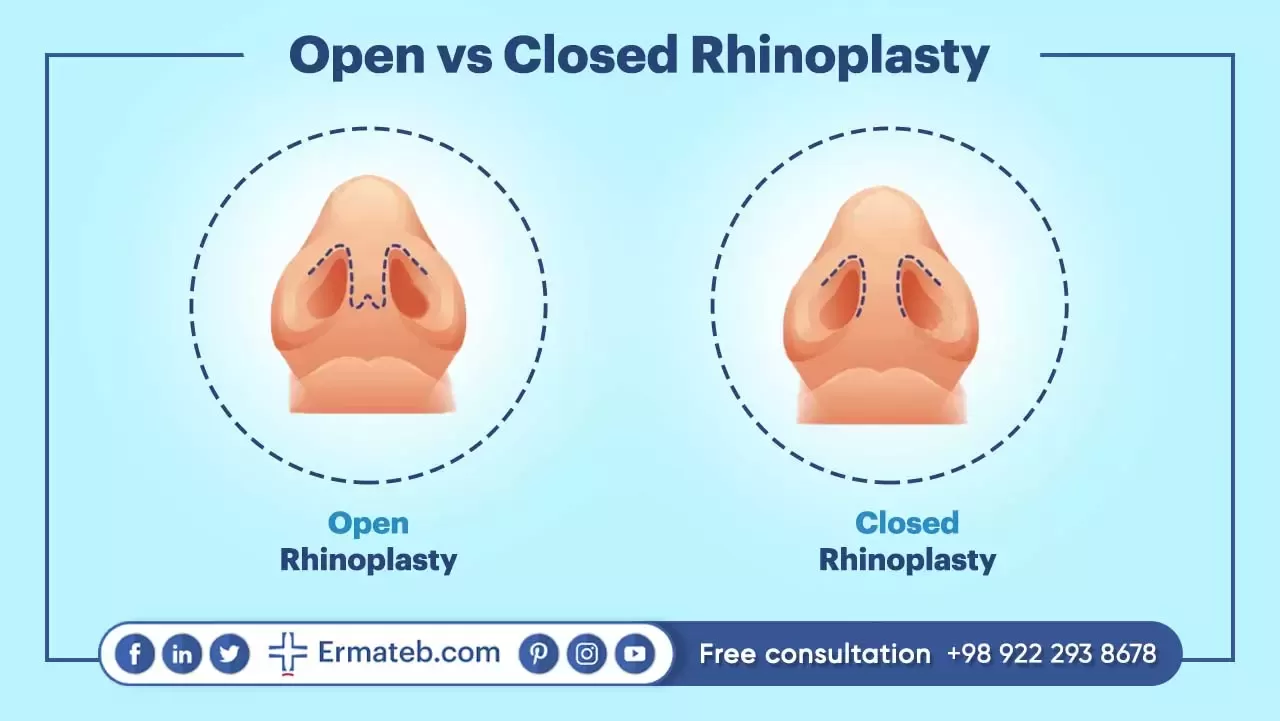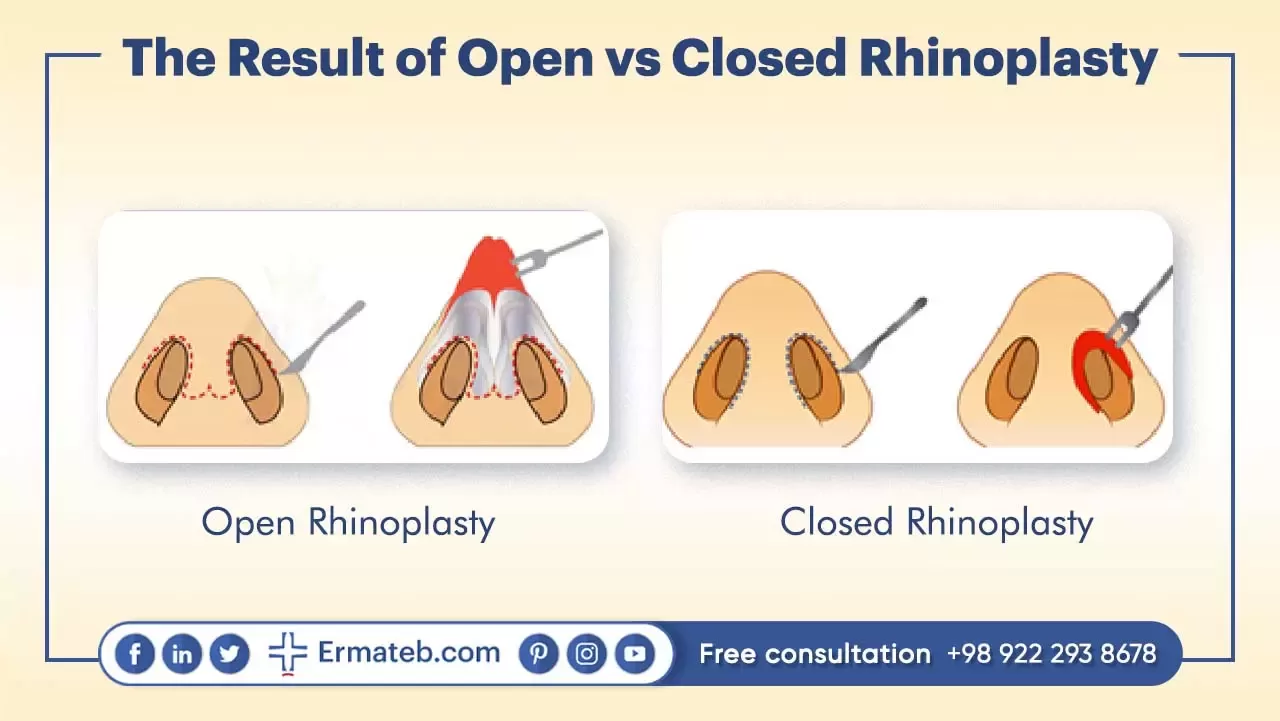
Rhinoplasty is a well-known plastic surgery procedure that involves altering the shape and structure of the nose to achieve a more harmonious appearance. This is a popular choice for many people seeking a nose job. During the procedure, the surgeon will make changes to the size of the nose, nostrils, cartilage, and bones in order to achieve the desired result.
Nose surgery, also known as rhinoplasty, can effectively improve various issues such as polyps and breathing problems. There are two methods for rhinoplasty: open and closed. In this article, we will review and compare both methods.
When considering open vs closed rhinoplasty, it's important to understand why your doctor may recommend one method over the other. What specific factors does the doctor take into consideration when determining which method is right for you?
Before selecting a technique, a comprehensive evaluation of the nose's structure should be conducted. Once the key factors have been measured, it can be determined whether an open or closed rhinoplasty is the most suitable choice.
In order to achieve more accurate results, a comprehensive examination of the basal, frontal, and lateral views of the nose is conducted. The nose is divided into upper, middle, and lower thirds, and then, each section is analyzed for width, symmetry, nasal bone width, tip location, tip shape, contour irregularities, columellar/alar relationships, shape, rotation, length, and the size and shape of the nostrils.
The surgeon needs to assess the thickness of the patient's nasal skin. Thicker skin may require more extensive changes to achieve the desired outcome, and recovery time may be longer with more complications.
It is important to assess the tip support, shape/size, and position of the nasal bones, as well as the integrity of the caudal septum by touching the nose.
To evaluate the inferior turbinates, septum, and nasal valves, it is important to examine the nostrils.
After analyzing all the factors, the surgeon recommends the appropriate course of action.

There are two methods for rhinoplasty. In both methods, the nose's skin is lifted, and the bones and cartilage are adjusted before the skin is put back. The goal of both open and closed rhinoplasty is to improve the appearance of the nose. Therefore, a nose job requires a combination of artistic and scientific skills.
Although there are similarities, these methods have significant differences. First, we will provide an overview of each method, and then we will delve into their individual pros and cons.
Closed rhinoplasty involves making minor incisions, resulting in a shorter recovery time and earlier removal of scars. Patients also experience a more comfortable recovery compared to open rhinoplasty, which has a higher risk of complications. During the recovery period, patients who underwent open rhinoplasty typically experience more pain and swelling.
Compared to open rhinoplasty, closed rhinoplasty has more limitations because the surgeon operates on the nose through the nostrils. This makes the surgery more difficult and delicate.
The process of open rhinoplasty requires more time because it involves making changes at a larger scale.
In closed rhinoplasty, the stitches are inside the nose and they are removed through absorption. Additionally, incisions made through the closed method become less visible over time.
During open rhinoplasty, the incisions made are more extensive and deeper, so internal stitches are absorbed while external stitches are removed during the recovery period. After the procedure, scars may be visible due to the mid-columellar inverted-V incision made between the nostrils.
However, with time, the scar will gradually improve until it becomes invisible. In some cases, the scar may persist, which can be bothersome to some patients. For those who are concerned about scarring, closed rhinoplasty may be a better option.
Read More: Functional Vs Cosmetic Rhinoplasty
One way to perform this technique is through a mid-columellar inverted-V incision. It is important to select the incision site with care, choosing an area where the underlying cartilage is closest to the skin. This can help prevent scarring and contracture.
This method of rhinoplasty is called open rhinoplasty because the surgeon can access all parts of the nose, including the cartilage, septum, and external nostrils. The patient is placed under general anesthesia during the procedure. To begin, the surgeon makes an incision in order to lift the skin of the nose.
If a patient has excessive flesh on their nose or requires further surgery, the doctor may suggest open rhinoplasty. This procedure is also commonly performed in cases where the patient has nasal tumors, polyps, or congenital disabilities.

When considering the differences between open and closed rhinoplasty, it's important to weigh the advantages and disadvantages of each. In this article, we will provide a detailed overview of both options.
During an open rhinoplasty procedure, the surgeon makes an incision to lift the skin of the nose and gain access to all parts of it. This method enables the surgeon to correct any asymmetry, defects, or abnormalities that may not have been detected during the examination beforehand.
To achieve a satisfactory result, open rhinoplasty of the nose can be a viable option if your surgeon is experienced, skilled, and knowledgeable about the anatomy's variations.
In fact, the surgeon is able to perform the nose job with greater precision and accuracy during an open rhinoplasty procedure.
For patients with issues such as crooked or deformed noses, as well as those who have undergone unsuccessful primary surgeries, an open rhinoplasty is the recommended course of action. This method allows the surgeon to effectively address any previous defects and significant problems.
Read More: Pollybeak Deformity
Surgeons may use grafts and prostheses to reshape the bridge and tip of the nose, provide additional support to its structure, and increase the length of the septum.
During open rhinoplasty, the placement of grafts and prostheses is more precise and easier for the surgeon. This is because they have access to all parts of the nose, which often results in more satisfactory outcomes.
Although open rhinoplasty has its advantages, it also has some disadvantages. In certain cases, it may not be the preferred method for a nose job.
It is normal to experience low bleeding, bruising, swelling, and temporary loss of sense of smell after undergoing open rhinoplasty. These complications typically go away within 10 to 14 days. However, some patients may experience more serious issues such as high bleeding, asymmetry of the nostrils, or failure to remove a nasal hump. These problems can arise if the surgeon is inexperienced. Therefore, it is important to carefully consider the doctor and clinic you choose for your procedure.
The recovery time after open rhinoplasty is crucial for patients. This surgery is challenging and delicate, so recovery requires special care. Patients hope to recover quickly, but unfortunately, it typically takes four to seven days.
It can be bothersome that tampons are placed inside the nose and bandages cover part of the face during recovery. During this time, patients may experience swelling, nasal congestion, headaches, pressure in the nose, and nausea. These symptoms are common and should be expected. It's important to understand that complete healing can take up to two to three weeks.
The duration of an open rhinoplasty is typically between 1.5 to 3 hours. Occasionally, patients may experience a delayed awakening from anesthesia, which can take a few hours.
Undergoing open rhinoplasty can result in more visible scars that may take longer to fade away.
Read More: Natural Rhinoplasty
Closed rhinoplasty is a less invasive option compared to open rhinoplasty, especially when only minor changes are needed. During closed rhinoplasty, the surgeon works through the nostrils instead of making external incisions, which limits their access to certain areas of the nose. Patients should not expect drastic changes after the procedure as the surgeon mainly focuses on making small alterations by lifting the skin through a small incision.
The incisions will be closed with absorbable stitches, so the patient need not worry about visible scars or stitches.

Closed rhinoplasty is a technique that is sometimes preferred over open rhinoplasty because of its advantages. Although surgeons often prefer the open method, closed rhinoplasty can still make tiny changes. Below, we have listed some of these changes.
Some cases opt for closed rhinoplasty to minimize swelling and bruising.
As previously mentioned, closed rhinoplasty involves making small incisions inside the nose.
The nose job procedure will typically last between 30 and 90 minutes.
This method is less invasive, as it requires fewer internal incisions. Stitches can be easily absorbed without the need for special care after the operation.
The closed rhinoplasty procedure results in a quicker recovery time and fewer complications due to the minor intensity and level of changes made to the patient.
One of the biggest concerns with the closed method is how it can affect the final outcome. Reviewing the disadvantages can help to provide a better understanding of this issue.
During a closed rhinoplasty, the surgeon may not have complete access to all parts of the nose, which can result in unsuccessful changes or even damage to the nose structure. Open rhinoplasty is often preferred for patients with a damaged nose or those needing revision rhinoplasty due to its wider range of possibilities. However, it's important to note that the closed method does have its limitations.
It can be difficult to find a skilled surgeon who can perform a closed rhinoplasty with precision, as many surgeons tend to opt for the open approach.
After undergoing closed rhinoplasty, the patient may experience respiratory problems for a few days.
Don't worry about recovery time in closed rhinoplasty. You may experience congestion, low bleeding, slight swelling, and bruising, but these are normal complications.
Most patients will typically recover within a short period of time, allowing them to resume their daily activities and return to work.
Recovery time for rhinoplasty can vary, with some patients needing up to two weeks. It's crucial for these patients to carefully follow post-operative care instructions and guidelines to ensure proper healing
The surgeon will analyze the defects, shape, and structure of your nose to determine the most appropriate method for your needs. The chosen method will depend on the shape of your nose and your expectations.
When it comes to choosing a surgical procedure, the most important factor is choosing the best and most experienced surgeon. So, instead of focusing on the method, prioritize finding a top-notch doctor. Ultimately, the decision is in your hands.

If an experienced surgeon performs the surgery, both open and closed rhinoplasty techniques can result in satisfaction. However, it's important to note that open rhinoplasty allows the surgeon to access all sections of the nose, providing greater accuracy during surgery. In contrast, closed rhinoplasty is limited in practicality as the surgeon faces limited access, potentially leading to less optimal results.
If you're worried about scars after a rhinoplasty, you may wonder if the color of your skin will affect how visible they are. However, it's important to note that skin color actually has no impact on the appearance of scars.
Proper recovery time and aftercare are crucial for achieving the desired outcome of a nose job. Whether it's an open or closed rhinoplasty, both techniques require careful aftercare. Here are some important tips to keep in mind:
• Avoid blowing your nose
• Refrain from bending your head, especially while sleeping
• Use a cold compress three times a day to reduce swelling
• Do not smoke or drink alcohol
• Consume soft foods like soup
• Drink plenty of water and juice
• Use saline spray and ointments as directed
• Avoid strenuous activity for at least two weeks
• Keep your nostrils open when sneezing
• Do not clean your nose with your fingernail or any other object
• If there is any bleeding, gently clean the area with sterile gauze
• Do not wash your face for at least seven days after rhinoplasty, and only resume your skincare routine as directed by your doctor.
In this article, we have provided a detailed comparison between open and closed rhinoplasty techniques. It's important to consider the pros and cons of each technique based on factors such as the shape of your nose, any defects present, and your expectations for the surgery.
When considering a nose job, it's important to thoroughly research and find an experienced and skilled surgeon. The surgeon you choose is the main factor that can affect the outcome of the procedure. If your surgeon is highly skilled, they can handle any challenges that may arise, such as defects, complications in anatomy and structure, or the method of surgery (open or closed rhinoplasty).

